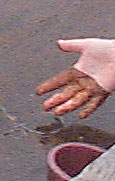

Blooms occur when, under favorable conditions, phytoplankton suddenly increase in numbers. A healthy case is the springtime bloom of diatoms that occurs when sunlight and wind-mixed nutrients are readily available in the upper ocean. Harmful Algal Blooms (HABs) occur when plankton growth harms other species within the food web. Many HABs involve phytoplankton that are not toxic but are harmful in other ways. For instance, thick blooms in surface waters can block sunlight from species below, the decomposition of bloom cells can deprive other organisms of oxygen, and blooms of diatoms with spines can clog the gills of fish and zooplankton. Some HABs are caused by excess nutrients, from either natural or human-derived sources. Scientists have the goal of detecting potential HAB conditions using remote imaging methods including satellites and buoys.
"RED" & "BROWN TIDES"

In some instances, phytoplankton cells become so abundant that they alter ocean color. The resulting color depends on how sunlight is absorbed and scattered by phytoplankton cells within seawater. "Red Tide" is a common name for the phenomenon where certain phytoplankton species that contain reddish pigments bloom in great numbers, seemingly turning waters to red. The term "Red Tide" is misleading because these events are not tied to tides. It is also important to note that phytoplankton species within so-called "Red Tides" may or may not be toxic. Less familiar "Brown Tides" result from blooms of phytoplankton such asAureococcus. "Brown Tides" have caused persistent problems in coastal waters since they were first observed in Long Island Sound in 1985. Aureococcus grows in such thick layers during these episodes that sunlight is unable to penetrate to underwater plants, destroying nursery habitats, clogging shellfish gills, and eliminating entire populations of many commercial species, including bay scallops.
TOXIC ALGAL BLOOMS

Many -- but not all -- toxic algal blooms are associated with dinoflagellates. Only a few species of dinoflagellates are toxic but they produce a wide variety of illnesses including Paralytic, Diarrhetic and Neurotoxic Poisoning. These toxins, which are transferred through the food web, can pose serious risks to humans and marine mammals who eat contaminated seafood. In the eastern United States and many other parts of the world, humans risk death from Paralytic Shellfish Poisoning if they eat shellfish that have accumulated a particularly dangerous poison produced by dinoflagellates of the genus Alexandrium. These toxins are believed to have resulted in the death of a pod of humpback whales several years ago in the Gulf of Maine, while another dinoflagellate, known as Karenia breve, was recently responsible for the death of a large number of Florida's endangered manatees. Different types of dinoflagellates have also caused serious economic damage and health problems in Chesapeake Bay.









